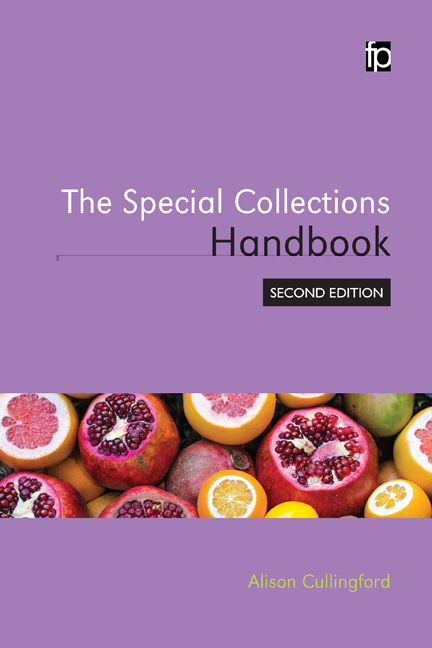Book contents
- Frontmatter
- Contents
- Preface and acknowledgements
- Introduction
- 1 The care of Special Collections
- 2 Emergency planning for Special Collections
- 3 Understanding objects in Special Collections
- 4 Acquiring and developing Special Collections
- 5 Cataloguing, description and metadata in Special Collections
- 6 Digitization and digital libraries in Special Collections
- 7 Legal and ethical issues in Special Collections
- 8 User services in Special Collections
- 9 Marketing and communications in Special Collections
- 10 Widening access to Special Collections
- 11 Organizational resources for Special Collections: space and people
- 12 Influencing and fund-raising for Special Collections
- Afterword: Special Collections futures
- Appendix A The Special Collections reference shelf
- Appendix B Skills for your Special Collections career
- Bibliography
- Index
3 - Understanding objects in Special Collections
- Frontmatter
- Contents
- Preface and acknowledgements
- Introduction
- 1 The care of Special Collections
- 2 Emergency planning for Special Collections
- 3 Understanding objects in Special Collections
- 4 Acquiring and developing Special Collections
- 5 Cataloguing, description and metadata in Special Collections
- 6 Digitization and digital libraries in Special Collections
- 7 Legal and ethical issues in Special Collections
- 8 User services in Special Collections
- 9 Marketing and communications in Special Collections
- 10 Widening access to Special Collections
- 11 Organizational resources for Special Collections: space and people
- 12 Influencing and fund-raising for Special Collections
- Afterword: Special Collections futures
- Appendix A The Special Collections reference shelf
- Appendix B Skills for your Special Collections career
- Bibliography
- Index
Summary
Introduction
Objects in Special Collections include any format that has ever been used for communication, from papyri to digital files. Librarians need to understand the objects in their collections to manage them effectively. Understanding the materials and construction of objects is essential to make the right choices in preserving Special Collections, while understanding their context and creation helps with acquiring, marketing and sharing them with readers. Roles in national or other large libraries are often specialist, calling for doctorate-level expertise in a particular format or historical period, such as medieval manuscripts, rare books or maps. Roles in smaller services are more generalist, and such services are less likely to own or acquire the widest range of materials.
This chapter introduces the formats that are the historic basis of Special Collections, as foundation collections or gathered by antiquarians and bibliophiles: manuscripts and early printed books. It also covers common modern formats with preservation issues.
Medieval manuscripts.
Early printed books (including typography, paper, illustrations and bindings).
Analytical bibliography.
Modern publications.
Important printed formats: private press, artists’ books, ephemera and other fugitive materials.
Audiovisual media, photographs and plastics.
Digital media.
A note on terminology
Book is nowadays used for published works. However, the term originated to refer to folded sheets sewn into a binding (or, later, cut sheets glued into a case). The book had many advantages over rival formats like rolls, scrolls and tablets: it was portable, compact and made it easy to access any point in the text. To distinguish printed works from manuscripts bound in book form, the term printed book is used. Codex is another word for the book format, mostly now used for medieval manuscripts.
Bibliography is used for many kinds of lists about books, including the list at the end of this work. The term also means the study of books as physical objects; this chapter introduces analytical bibliography. Codicology is the study of manuscripts; palaeography the study of handwriting. The term diplomatics is also used: the study of documents to establish whether they are authentic.
- Type
- Chapter
- Information
- The Special Collections Handbook , pp. 47 - 66Publisher: FacetPrint publication year: 2016



